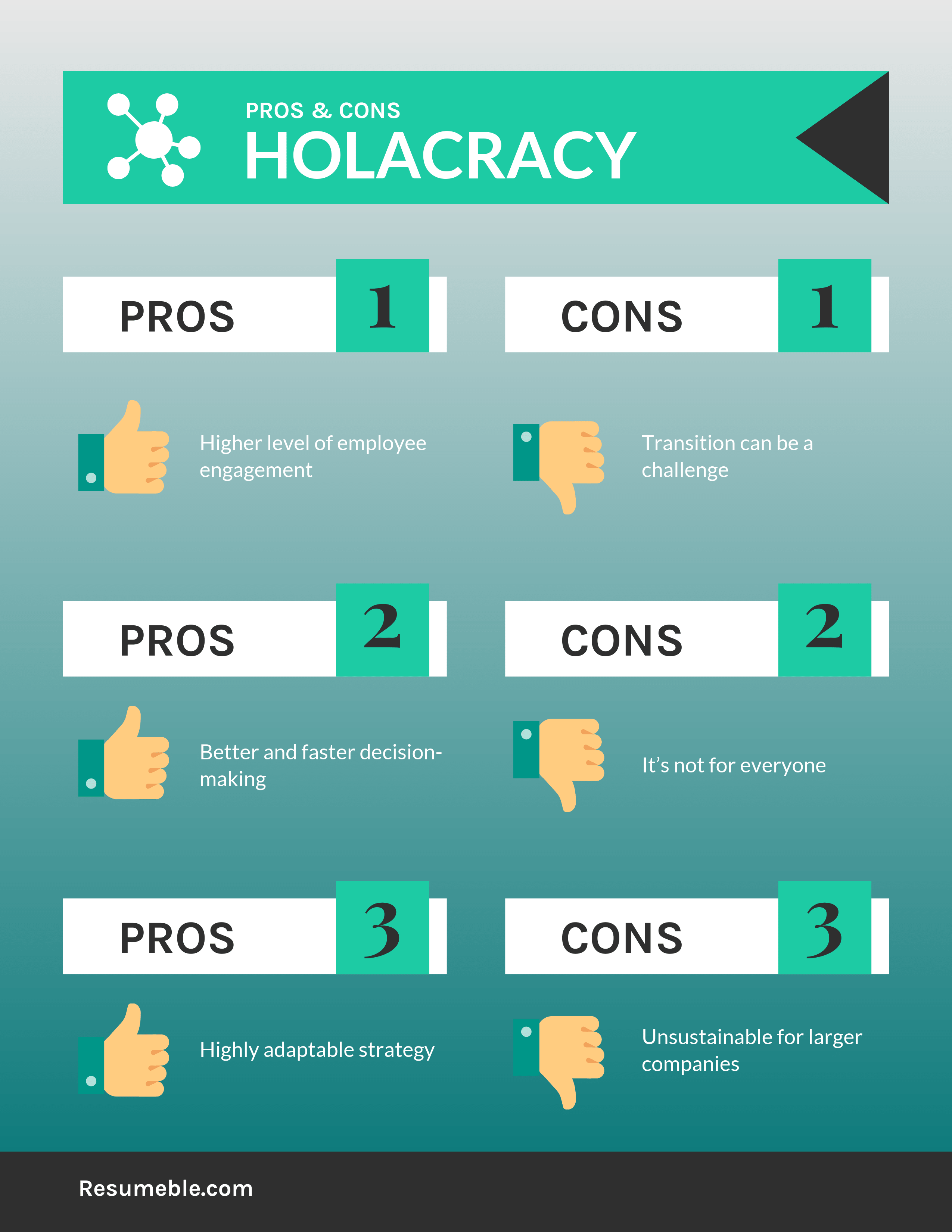Holacracy might be an answer to the ever-changing workplace, specifically in firms where employees - particularly Millennials and Gen Zs - thrive in linear organizational structures that allow more flexibility and freedom.
Now you might ask, what is holacracy? Although it might sound like a radical, new age approach, it’s really not. In the last decades, business organizations have been trying to find ways to boost employee productivity and replace bureaucracy.
Read on to learn more about what holacracy is all about, what makes it unique, and how it can become a means for success in an organization.
Holacracy in Practice
Basically, holacracy aims to avoid the pitfalls encountered by the average workplace through four key differences:
- Roles instead of job titles and managers
- Circular structure/teams
- Rapid iterations
- Transparent rules as written in the 400-page holacracy constitution
In a holacratic workplace, employee roles are spread out in circles, and employees have the flexibility to take on roles and tasks that interest them. They can even move between teams freely, provided that their efforts are still aligned with the organization’s purpose and goals.
Take note, however, that despite not having a hierarchy, a holacracy does not mean a lack of structure. In fact, holacracy has a clear and formal structure as guided by the holacracy constitution, but this structure is quite flexible.
Zappos, an online shoe and clothing retailer based in Las Vegas, is among the largest companies implementing holacracy. With around 1,500 employees, Zappos went holacratic in 2014 to curtail office politics and allow the business to evolve efficiently. Medium, an online publishing platform with just under 200 employees, also dabbled with holacracy.
Holacracy in 2025: Is It Growing or Fading?
When holacracy first gained attention nearly a decade ago, companies like Zappos and Medium made headlines for tossing out traditional job titles in favor of role-based, self-managed systems. While some of those early experiments met mixed results, the idea of decentralized decision-making never fully disappeared. Instead, it evolved — quietly embedding itself into the DNA of newer, more flexible ways of working.
In 2025, holacracy isn’t exactly mainstream, but its influence is visible. As more companies operate in hybrid or remote environments, there’s renewed interest in flat structures, autonomous teams, and role fluidity — all core ideas of holacracy. Startups and creative agencies, in particular, are adopting hybrid models that borrow from holacratic principles without fully embracing the system.
Many modern teams now blend agile frameworks with self-organizing principles, creating work environments where employees are empowered to lead initiatives, define their roles, and make decisions without waiting for top-down approval. Tools like Notion, Loom, and Slack have made distributed collaboration more seamless, making holacracy-style management easier to implement.
So, is holacracy fading? Not really. It’s reshaping itself — less as a rigid system, and more as a mindset that’s quietly guiding the way teams build, lead, and grow in today’s flexible workplace.
How to Succeed in a Holacratic Workplace
Working in an organization that embraces holacracy can be both exciting and challenging. With no traditional hierarchy to lean on, success depends largely on your ability to take initiative, communicate clearly, and own your role without constant management oversight.
People who thrive in these environments are not necessarily team players. They do not wait for someone to tell them what to do. Instead, they identify what needs to be done and get to it. Being comfortable with feedback, staying adaptable, and knowing how to collaborate across roles are essential traits in a holacratic structure.
If you're looking to apply to a holacratic company or a similar model, tailor your resume accordingly. Highlight experiences where you've worked in non-hierarchical teams, and try to emphasize skills like:
- Cross-functional leadership – coordinating efforts across departments without formal authority
- Agile communication – staying clear and concise, especially in remote or async environments
- Process ownership – taking full responsibility for delivering outcomes
- Conflict resolution – navigating disagreements without relying on top-down escalation
As with all soft skills, consider not just mentioning them in a separate block but naturally sprinkling them across your professional experience, supported by measurable accomplishments.
Pros and Cons of Holacracy in the Workplace

As with any other management system, holacracy has its own share of ups and downs. The following are some holacracy pros and cons that you should know about:
Advantages
✅ Higher level of employee engagement – since employees don’t answer to “bosses” and are allowed to work freely on what interests them, they tend to become more responsible and empowered. Each person can fulfill their roles undisturbed as long as it is in the best interest of both their circle and the company.
✅ Better and faster decision-making – this is among the most important benefits of holacracy. Given that power is evenly distributed, individuals can act immediately. There is no need to wait for the approval or decision from the higher-ups.
✅ Highly adaptable strategy – holacratic companies can update their structure on a monthly basis. Teams reevaluate their purpose, and circles may move on to a new purpose or be dissolved completely. This allows the company to quickly address critical problems while maintaining a sense of continuity.
Disadvantages
❌ Transition can be a challenge – transitioning from a hierarchical to a holacratic structure can be difficult, what with holacracy’s entirely new concept and the extensive holacracy constitution. Holacracy training will be necessary, and a company may need to hire experts to guide them in the transition and implementation process. It might work, or it can become a total disaster. This is a risk that a business firm must be willing to take.
❌ It’s not for everyone – considering the nature of holacracy, employees who are likely to thrive in this structure should be independent thinkers and good self-managers. Unfortunately, not everyone can fit that profile, and not all may be willing to adjust and adapt to a new system of working.
❌ Not very sustainable (although not impossible) for larger companies – with the sheer number of circles and teams that need to be created, holacracy may not be feasible for bigger companies. When it comes to larger initiatives that call for coordination across functions, it can be divisive and time-consuming to achieve alignment.
How to Mention Holacracy on Your Resume

If you've worked at a company that practices holacracy - or a similar flat structure - you might be wondering how to position that experience on your resume. The good news is that you should absolutely mention it, especially if you have grown in autonomy, leadership, and collaboration.
Holacratic environments require a unique mix of initiative, adaptability, and communication ability — skills that are highly valued in roles in project management, operations, product development, and UX. Frame your experience in a way that speaks to the outcomes, not just the structure and responsibilities.
Here are a few examples of how to phrase it on your resume:
- "Led a self-organizing team to deliver a cross-functional project 2 weeks ahead of schedule, following holacratic principles."
- "Served as Circle Lead, rotating between project owner, process manager, and facilitator roles to drive team accountability and delivery."
If you're applying outside of similar holacratic companies, use your previous experience to show that you're comfortable with autonomy, thrive in fast-moving environments, and can lead without relying on traditional hierarchy. It's not just a resume buzzword — it's a strong signal that you can operate with agility and ownership.
Career Growth in Holacracy
In holacratic organizations, traditional hierarchies are replaced by self-managed teams and fluid roles. So, one common question professionals face is: How do I grow my career without a clear ladder to climb? This is a valid concern. Without job titles or managerial tiers, the typical markers of progress can feel absent. But that doesn't mean career development isn't possible. It just looks different.
In companies that embrace holacracy, progression is less about climbing a traditional corporate ladder and more about expanding your influence, deepening skills, and gaining ownership over projects.
To succeed in a holacratic environment, focus on honing such skills as reliability, clarity, and initiative. Since performance is often assessed through peer feedback and the value you bring to each role, communication and accountability matter even more.
In short, career progression in a holacratic workplace is self-directed and extremely rewarding if you are comfortable with autonomy and ambiguity.
Stay Holacracy-Ready... Or Not
Holacracy may not be the standard structure by which all companies operate, but when you’re out searching for a job, it pays to be familiar with various business organizational trends, as you may very well find your dream position in a company that practices it.
There is also no shame in not being okay with a holacratic workplace. Some of us value stability, clearly defined roles, and a top-down leadership style more than others. If you find yourself overwhelmed by a holacratic office, consider looking outside for jobs that offer more guidance and stability. A more conventional management model might be a better fit for you.
The best career path is the one that feels sustainable and authentic to you.
Let us take care of writing and organizing your resume, while you research and learn about your target companies and enhance your knowledge on the latest business trends. Give us a call today, and we’ll take the resume writing or revising off your to-do list.
